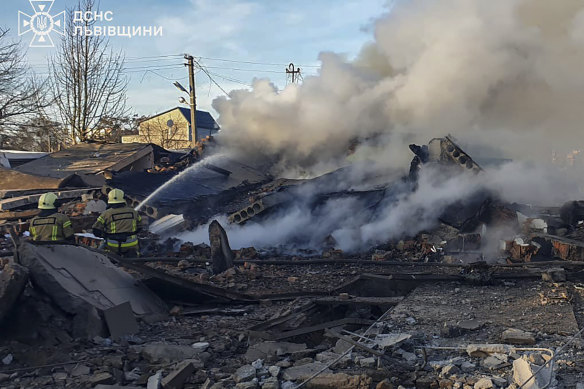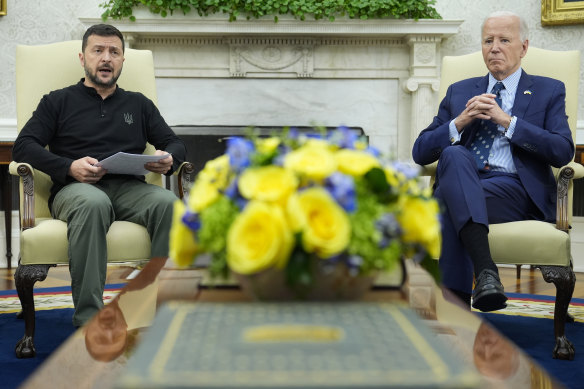This was published 6 months ago
Biden lifts ban on Ukraine using US arms to strike inside Russia
By Mike Stone and Humeyra Pamuk
Washington: US President Joe Biden’s administration has lifted restrictions that had blocked Ukraine from using US-supplied weapons to strike deep into Russian territory, three sources familiar with the matter have said, in a significant change to US policy in the Ukraine-Russia conflict.
Ukraine plans to conduct its first long-range attacks in coming days, the sources said, without revealing details due to operational security concerns.

In this photo provided by the Ukrainian Emergency Service, emergency services personnel work to extinguish a fire following a Russian rocket attack in Lviv, Ukraine, on Sunday.Credit: AP
The White House declined to comment.
The move came after Russia launched a massive drone and missile attack on Ukraine, described by officials as the largest in recent months, targeting energy infrastructure and killing civilians. It raised fears about Moscow’s intentions to devastate Ukraine’s power generation capacity ahead of the northern winter.
Ukrainian President Volodymyr Zelensky’s reaction was notably restrained.
“Strikes are not made with words,” he said during a video address. “Such things are not announced. The missiles will speak for themselves.”
Zelensky’s statement came shortly after he posted a message of condolence on Telegram following a Russian attack on a nine-storey building that killed at least eight people in the northern city of Sumy, 40 kilometres from the border with Russia.
Earlier Zelensky said Russia had launched a total of 120 missiles and 90 drones in the large-scale attack across Ukraine on Sunday. Various types of drones were deployed, he said, including Iranian-made Shaheds, as well as cruise, ballistic and aircraft-launched ballistic missiles. He said the target was the energy infrastructure throughout Ukraine.
Ukrainian defences shot down 144 out of a total 210 air targets, Ukraine’s air force reported.
“And this is the answer to everyone who tried to achieve something with Putin through talks, phone calls, hugs and appeasement,” Zelensky said.
The comment appeared to be a dig at German Chancellor Olaf Scholz, who spoke on Friday with Putin in the first such call with a sitting head of a major Western power in nearly two years.
In Mykolaiv, as a result of a drone attack, two people were killed and six others were injured, including two children. Two more people were killed in the Odesa region, where the attack damaged energy infrastructure and disrupted power and water supplies, said Oleh Kiper, the local governor. Both victims were employees of Ukraine’s state-owned power grid operator, Ukrenergo, the company said hours later.
The combined drone and missile attack was the most powerful in three months, said the head of Kyiv’s City Military Administration, Serhii Popko.

In this photo provided by the Ukrainian Emergency Service, a psychologist helps a woman who lost her home in a Russian missile attack in the Odesa region of Ukraine on Sunday.Credit: AP
Biden’s decision to allow Ukraine to use US-supplied weapons deeper inside Russia follows months of requests by Zelensky to allow Ukraine’s military to hit Russian military targets far from its border.
The change follows Russia’s deployment of North Korean ground troops to supplement its own forces, a development that has caused alarm in Washington and Kyiv.
The first deep strikes are likely to be carried out using ATACMS rockets, which have a range of up to 306 kilometres, sources say.
While some US officials have expressed scepticism that allowing long-range strikes would change the war’s overall trajectory, the decision could help Ukraine just as Russian forces are making gains, and possibly put Kyiv in a better negotiating position when and if ceasefire talks take place.
Some Ukraine supporters have argued that the US constraints on long-range weapons could cost Ukraine the war. The debate has become a source of disagreement among Ukraine’s NATO allies.
Biden had remained opposed, determined to hold the line against any escalation that he felt could draw the US and other NATO members into direct conflict with Russia.
It is not clear if President-elect Donald Trump, who takes office on January 20, will reverse Biden’s decision. Trump has long criticised the scale of US financial and military aid to Ukraine and has vowed to end the war quickly, without explaining how; Trump has said he would seek a quick deal between Ukraine and Russia.
Still, some congressional Republicans have urged Biden to loosen the rules.
The capability would most likely be used first in the Kursk region of Russia, where Ukraine is fighting against North Korean troops as well as Moscow’s forces, sources told Bloomberg on condition of anonymity.

Ukrainian President Volodymyr Zelensky with US President Joe Biden in the Oval Office in September.Credit: AP
Moscow, with Pyongyang’s help, has been trying to dislodge Ukrainian forces from Kursk after they captured some areas in a surprise incursion earlier this year. Some leaders will most likely raise the issue of North Korean military involvement, including with China, at the G20 leaders summit in Brazil this week.
Pyongyang has also supported Russia with millions of rounds of artillery ammunition and other weapons. The US is expected to adopt more sanctions against North Korea before Biden leaves office, some of the people said.
Russia has warned that it would see a move to loosen the limits on Ukraine’s use of US weapons as a major escalation.
Reuters, AP, Bloomberg
Get a note directly from our foreign correspondents on what’s making headlines around the world. Sign up for our weekly What in the World newsletter.